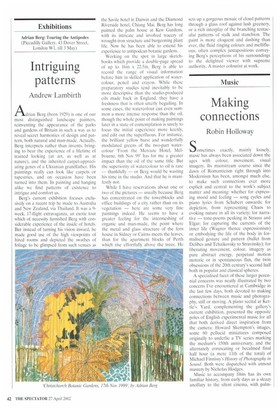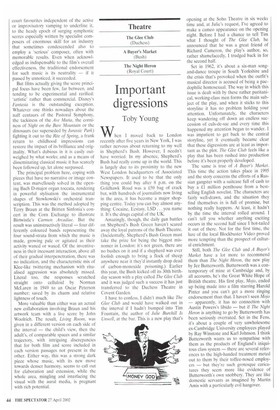Music
Making connections
Robin Holloway
Sometimes exactly, mainly loosely, music has always been associated down the ages with colour, movement, visual imagery. Its mainstream course since the dawn of Romanticism right through into Modernism has been, amongst much else, to make such connections ever more explicit and central to the work's subject matter and meaning: whether for expressing mood and feeling — song cycles and piano lyrics from Schubert onwards; for depiction, from representing Chaos to evoking nature in all its variety; for narrative — tone-poems peaking in Strauss and Elgar; for capturing the currents of the inner life (Wagner thence expressionism) or embodying the life of the body in formalised gesture and pattern (ballet from Delibes and Tchaikovsky to Stravinsky); for liberating movement, colour, imagery as pure abstract energy, perpetual motion motoric or in spontaneous flux, the twin obsessions of the 20th century's second half both in popular and classical spheres.
A specialised facet of these larger perennial concerns was neatly illustrated by two concerts I've encountered at Cambridge in the last few days, both devoted to making connections between music and photography, still or moving. A piano recital at Kettle's Yard, complementing the gallery's current exhibition, presented the opposite poles of English experimental music for all that both derived direct inspiration from the camera: Howard Skempton's images, some 60 pellucid miniatures composed originally to underlie a TV series marking the medium's 150th anniversary; and the alternately coruscating or becalmed final half hour (a mere 11th of the total) of Michael Finnissy's History of Photography in Sound. Both were dispatched with utmost mastery by Nicholas Hodges.
Music to accompany films has its own familiar history, from early days as a sleazy ancillary to the silent cinema, with palm court favourites independent of the active or improvisatory vamping to underline it, to the heady epoch of surging symphonic scores especially written by specialist composers of enormous skill for an industry that sometimes condescended also to employ a 'serious' composer, often with memorable results. Even when acknowledged as indispensable to the film's overall effectiveness, the traditional endorsement for such music is its neutrality — if it passed by unnoticed, it succeeded.
But films actually giving the score principal focus have been few, far between, and tending to be experimental and rarified: 'artistic' rather than commercial. Disney's Fantasia is the outstanding exception. Whatever one thinks nowadays about the naff centaurs of the Pastoral Symphony, the tackiness of the Ave Maria, the corniness of Night on the Bare Mountain or the dinosaurs (so superseded by Jurassic Park) fighting it out to the Rite of Spring, a frank return to childhood impressions can restore the impact of its brilliance and originality. What's dubious in it is easily outweighed by what works; and as a means of disseminating classical music it has scarcely been followed up, let alone surpassed.
The principal problem here, coping with pieces that have no narrative or image content, was marvellously solved in the opening Bach D-major organ toccata, rendering in powerful stylisation the instrumental shapes of Stowkowski's orchestral transcription. This was the method adopted by Terry Braun at the Britten Sinfonia's concert in the Corn Exchange to illustrate Birtwistle's Carmen Arcadiae. But the result was uninstructively literal — four differently coloured bands representing the four sound-strata from which the music is made, growing pale or agitated as their activity waned or waxed. Of the inventiveness in their incessant interaction, above all of their gradual interpenetration, there was no indication, and the characteristic mix of Klee-like twittering mechanism with ritualised aggression was absolutely missed. Literal too, the responses scratched straight onto celluloid by Norman McLaren in 1949 to an Oscar Peterson number: saved by its charm and relative lightness of touch.
More valuable than either was an actual new collaboration involving Braun and his artwork team with a live score by John Woolrich. The result, Living Room, was given in a different version on each side of the interval — the child's view, then the adult's, of comparable spaces and a similar trajectory, with intriguing discrepancies that for both film and score included in each version passages not present in the other. Either way, this was a strong dark piece whose music, with its new move towards denser harmony, seems to call out for elaboration and extension, while the whole area, mingling and interfacing the visual with the aural media, is pregnant with rich potential.



































































 Previous page
Previous page